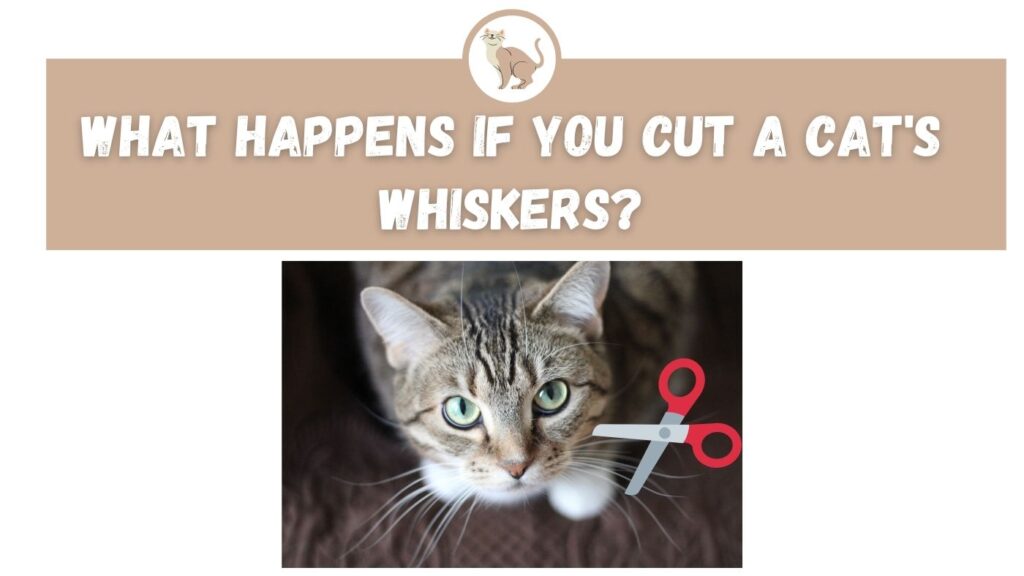Your cat’s whiskers, also known as tactile hairs or vibrissae, are an essential sensory mechanism. A cat’s whiskers are longer and thicker than the hair on her body.
A cat’s whiskers are extremely precious to them. It is very distressing for a cat to lose their whiskers. If you cut a cat’s whiskers, it will cause them not only discomfort but also become confused and disorientated.
What Happens If You Cut Off A Cat’s Whiskers
If you trim or cut off your cat’s whiskers, it might become disoriented or have trouble moving around. Felines need the entire length of their whiskers.
By cutting your cat’s whiskers, you are taking away a major part of their sensory abilities. Keep in mind that whiskers help your cat navigate the world around them. Cutting these whiskers is like removing one of their senses. It would be similar to if you took away a person’s ability to hear or smell.
Additionally, you should know that cat whiskers can take quite a bit of time to grow back.
Why do cats have whiskers?
Cat’s whiskers act similar to a radar or perception system, and relays to a cat a bunch of information on depth perception and even air pressure. The nerve endings on the end of the whiskers are what allows the cat to do this.
Cat’s whiskers are deeply rooted in follicles that are surrounded by muscle tissue, very rich in nerves and sensory cells. The supersensitive nerves and sensory cells at the base of the whiskers relay information to the cat whenever they are touched by something or moved by the air.
These sensory cells are then connected to a special area of the cat’s brain. Cats have a sensory organ, called the proprioceptor, at the end of their whiskers that sends messages to the brain.
Your cat’s whiskers do all of the following:
- Whiskers are your cat’s navigators. They help cats move smoothly in darkness. Blind cats rely almost solely on their whiskers to navigate.
- Whiskers help your cat navigate tight spaces and understand whether or not they can fit through a particular opening.
- Whiskers are sensitive to changes in the air current around an unknown object. Cats can pick up even small air movements which vibrate the cat’s whiskers.
- Whiskers enable a cat to avoid the obstacle. They help your cat judge distance and space.
- Whiskers provide advantages to cats when hunting. They allow hunting cats to silently move about and stalk prey in the dark. Whiskers can relay information to your cat that causes their back to twitch.
Bonus fact: When a cat is defensive or angry, its whiskers will be pulled back. When the cat is happy or content, the whiskers will be more relaxed and pushed forward.
How long are cat’s whiskers?
A cat’s whiskers generally grow out to equal the width of a cat. If your cat’s whiskers are very long, you don’t need to worry. Usually, the fluffier a cat is, the longer its whiskers. If you own a large cat, expect it to have longer whiskers to match its bigger body.
How many whiskers does a cat have?
Cat’s usually have 24 whiskers by their nose, with 12 on each side. However, this number can vary based on the breed and age of a cat. A cat also has whiskers above their eyes, but they are not as long. Some people refer to these as “cat eyebrow whiskers.”
Can you cut cat whiskers above the eyes?
You might have noticed your cat has long hair above its eyes. They have whiskers above their eyes, on the sides of their faces, on their chin, and even on their legs!
When the whiskers above a cat’s eyes detect danger, the cat closes its eyes to protect it from possible injury. When a cat is engaged in hunting its prey, the eye whiskers act as a second set of eyes when it’s otherwise occupied.
Cutting a cat’s whiskers above eyes deprives it of the sensory protection it needs in everyday life.
Do cat whiskers shed?
Just like the rest of your cat’s hair, their whiskers do fall out on their own and grow back. Like other hairs on a cat’s body, whiskers shed. They do go through natural growth, dormancy, and shedding phases and that’s normal. But you should never trim them.
Excessive whisker loss might be a sign of an allergy or other medical issue. If you notice excessive whisker breakage, speak to your vet to see if there is a medical cause.
Why are my cat’s whiskers curling?
There are two main reasons why your cat’s whiskers are curling.
- The whisker is new and still hasn’t reached its normal level of thickness. Once it becomes thicker, it will straighten out.
- Your cat is getting old, and their hair and whiskers are becoming weaker and more brittle.
Final thoughts
Whiskers are among the many fascinating things about cats. While they make our cats look interesting and unique, they do a lot more than just look cool!
A cat’s whiskers don’t just add to their cuteness! They have real work to do. These whiskers are not made for cutting! Keep in mind that they should not be clipped or trimmed!
Whiskers are GPS and radar systems for your kitty. Felines use their whiskers to make sense out of their environment. Without its whiskers, a cat might become disoriented and frightened.

